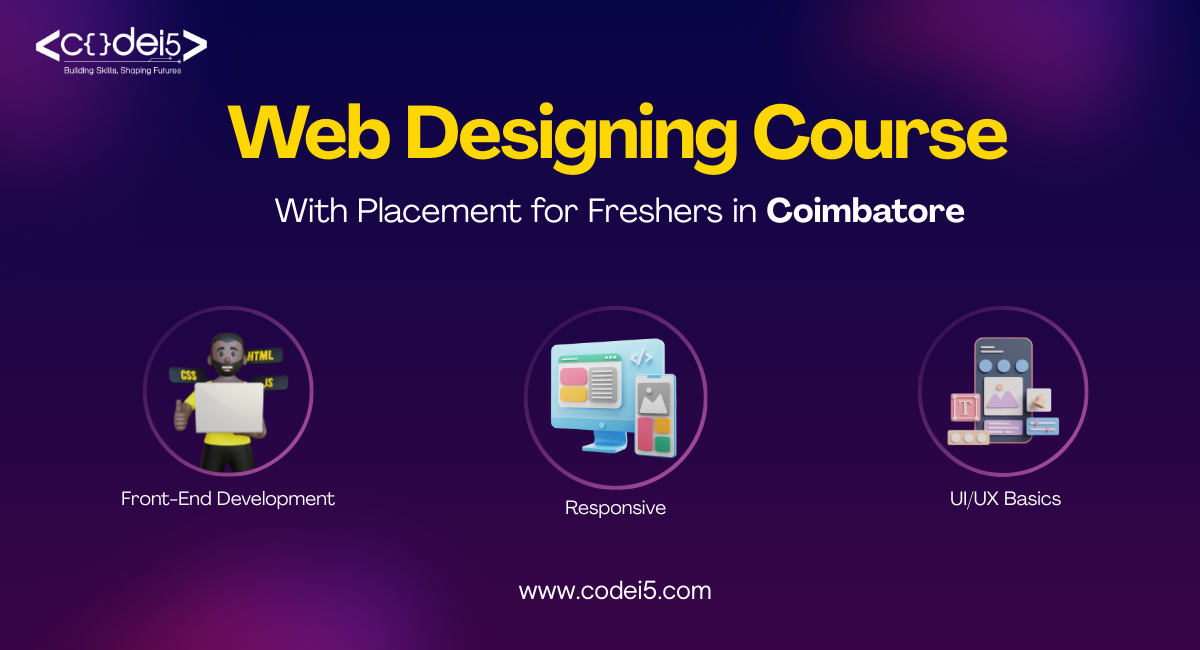
Becoming a web designer opens up a dynamic world where technology and creativity collide, allowing a digital canvas to come to life with each click. Learning and applying basic web design principles is essential to becoming a web designer so that your designs are aesthetically pleasing but also functional and user-friendly. You’re in the perfect place if you’ve ever been interested in creating visually stunning and easy-to-use websites. This guide is your key to learning the trade, developing the necessary abilities, and navigating the fascinating career path of becoming a web designer. Explore the fascinating world where creativity and code collide, and innovation is only a design away.
Develop Essential Skills for Web Designers:
Beyond only artistic talent, a competent web designer must possess a broad range of abilities. The following is a summary of the fundamental abilities that any web designer should develop:
1. HTML and CSS Expertise:
Recognize the basics of HTML so that you can organize material.
For the sake of style and layout, learn CSS.
Keep abreast of the most recent iterations and methodologies.
2. Proficiency in Graphic Design:
Proficiency with programs related to graphic design, such as Adobe Photoshop, Illustrator, or other programs.
Capacity to produce coherent and aesthetically pleasing designs
3. Designing with responsiveness:
Understand how to create responsive website designs on various screens and devices.
4. Designing User Experience (UX):
Gain a thorough understanding of user psychology and behavior.
Make designs that improve the overall experience and satisfaction of users.
5. Typography:
Fonts should be well-chosen and used for both readability and style.
Recognize how typography affects user experience.
6. Colour Theory:
Learn the fundamentals of color theory and use them to produce aesthetically pleasing and harmonious designs.
7. Creative Problem-Solving:
Gain the capacity to think creatively and effectively address design-related problems.
8. Coding Fundamentals:
Knowing a programming language like JavaScript will help you be more proficient, especially regarding interactive and dynamic aspects.
9. Understanding of Design Software:
To improve efficiency, keep up with the most recent design software and tools versions.
10. Knowledge of Search Engine Optimization:
To create search engine-friendly websites, understand the fundamentals of search engine optimization, or SEO.
11. Continuous Learning:
Remain curious and dedicated to lifelong learning, staying abreast of market developments and emerging technological trends.
12. Communication Skills:
Communicate design concepts to clients or team members in an effective manner.
Take, absorb, and apply criticism to ensure ongoing development.
By mastering these fundamental talents, aspiring web designers can not only satisfy the needs of the industry but also distinguish themselves as skilled and flexible professionals in the ever-changing world of web design.
Mastering Web Designing Tools:
Gaining proficiency with web design tools is essential for productivity and innovation in the dynamic world of web design. Take the best web design course to learn the fundamentals and open the door to a world of creativity and technical know-how that will enable you to create eye-catching and useful websites confidently. Here’s a tutorial to help you make the most of these crucial tools and navigate them:
1. Adobe Creative Cloud:
Photoshop: For graphic design and image editing.
Illustrator: Perfect for designing logos and vector graphics.
Experience design, or XD, is specifically suited for UX/UI design and prototyping.
2. Sketch:
- Sketch is a popular vector-based design tool in the design world that works well for making interactive prototypes and user interfaces.
- For many web designers, its user-friendly interface and emphasis on UI/UX design make it their first option.
3. Figma:
- Team members can work together in real-time with Figma, a collaborative design tool. Because it’s cloud-based, sharing and editing design files is a breeze.
- Because of its adaptability, it may be used for user testing, prototyping, and interface design.
4. InVision:
- Design animated and interactive prototypes can be made more easily with the help of InVision, a prototyping and collaboration platform.
- It is especially helpful for giving stakeholders and clients access to design concepts so they may interact more with the design.
5. GitHub:
- An essential component of web development is version control. GitHub is a collaborative coding and version control platform enabling several developers to collaborate on a project simultaneously.
- It is a crucial tool for recording and organizing project modifications for web design.
6. Contrast checkers and color pickers:
- Colors and the Adobe Color Wheel are two tools that can help you choose color schemes for your designs that work together.
- Accessibility is promoted via contrast checkers, like WebAIM’s Contrast Checker, ensuring that text is viewable against various backdrop colors.
7. Continous Learning and Updates:
- Web design is dynamic, and new technologies are always being developed. Keep abreast of the most recent additions and enhancements to your selected tools.
- To broaden your skill set, study new tools, engage in online networks, and adhere to approved documentation.
8. Tools for Browser Developers:
- The developer tools offered by browsers like Chrome, Firefox, and Safari should be known to every web designer.
- With the help of these tools, you can instantly examine and troubleshoot your website to ensure it works properly in all browsers.
9. Using Visual Studio Code or Sublime Text:
- The coding environment used by web designers is essential. Sublime Text and Visual Studio Code are popular text editors with many features, like syntax highlighting, autocompletion, and broad plugin support.
- These tools improve productivity and facilitate the process of coding JavaScript, HTML, and CSS.
10. Tools for Testing Responsive Designs:
- You can test and optimize your designs for various devices and screen sizes using tools like BrowserStack or ResponsivelyApp.
- Responsiveness is essential to provide a smooth user experience on PCs, tablets, and mobile devices.
Gaining proficiency with web design tools is a continuous process that calls for devotion and a desire to keep up with developments in the field. Gaining proficiency with these tools can improve your design skills and allow you to optimize your workflow for web design projects that are more effective and meaningful.
Create a Web Design Portfolio:
You can display the best design projects you’ve ever worked on, case studies, self-designed website templates, and even smaller-scale visuals like logos, typography, and illustrations. Remember to provide client testimonials to develop trust and demonstrate professionalism.
Put your best work up and center. Add a range of projects that showcase your skill and adaptability. For every undertaking:
- Give a brief overview of the project’s goals and your position.
- Project showcase photos or screenshots should be displayed.
- Talk about the tools and technology that were used.
- Emphasize any difficulties you have had and how you resolved them.
- If appropriate, provide a link to the active project.
Focus on a specific expertise to obtain more notoriety and clientele. Choose a specialization based on your interests and previous projects. You can also perform industry-specific market research to see whether your preferred niche is viable.
Ensure that you are easily accessible to potential customers. Give your phone number, email address, and easy-to-use contact form. Aside from showing design talents, developing your website will allow you to demonstrate your web programming skills.
How to apply for Web Designer Jobs:
A few procedures are involved in applying for a job as a web designer so that you can make the best possible impression of your qualifications and enthusiasm. Here’s how to apply for a job as a web designer, step-by-step:
Examine the job listings:
Look for career opportunities as a web designer on employment boards, business websites, or through personal contacts.
Read job descriptions carefully to determine the credentials and abilities needed.
Revisit Your Resume:
Make your resume stand out by emphasizing accomplishments, experiences, and pertinent abilities.
At the outset, include a brief overview or objective statement.
Establish a Portfolio:
Create a web portfolio that highlights your finest work in web design. Provide links to active projects or GitHub repositories, project descriptions, and images.
Ensure your portfolio is easy to explore, aesthetically pleasing, and well-organized.
Compose a Cover Letter:
Write a customized cover letter outlining your reasons for wanting to work as a web designer.
Emphasize how your experiences and relevant abilities meet the needs of the firm.
Examine the Company:
Find out about the company’s recent projects, values, and culture.
Make your application unique by highlighting how your values and abilities complement the organization’s objectives.
Remember to tailor each application to the particular position and employer that you are pursuing. You can improve your chances of sticking out from the competition by customizing your products and emphasizing your special strengths. I wish you luck!
How can I become a web designer with no experience?
Becoming a web designer without any prior expertise is feasible, and there are a few steps you may take to get started in the industry. Here is a starting point guide to assist you:
Learn the basics:
Start with the web design fundamentals, HTML, and CSS.
Designing with responsiveness:
Learn the fundamentals of responsive web design.
Design Resources:
Become proficient with Adobe Creative Cloud, Sketch, or Figma programs.
Fundamental JavaScript:
Learn the fundamentals of JavaScript for interactive elements.
Develop Your Portfolio:
Build a portfolio of personal work to highlight your abilities.
Internet-Based Communities:
Join groups for web design to gain knowledge and connections.
Online Education:
Enroll in a respectable web design training institute to gain the fundamental abilities and understanding required for a lucrative web design profession.
Participate in webinars:
Participate in webinars and workshops to stay current on industry developments.
Recall that consistency and a proactive approach to learning are essential when beginning your web design journey.
Conclusion:
To sum up, becoming a web designer requires a combination of technical know-how, artistic flair, and a dedication to lifelong learning. Gaining expertise in design tools and basic languages such as HTML, CSS, and JavaScript establishes the foundation. Professional development requires creating an impressive portfolio, participating in online groups, and keeping up with industry developments.






